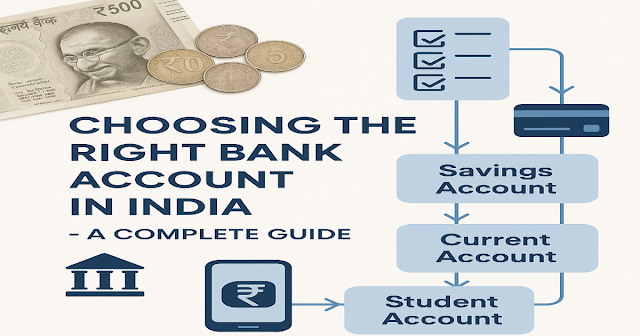 |
| How to Choose the Right Bank Account for Your Needs in India |
This guide will help you understand the different types of bank accounts in India, compare them, and choose the one that fits your financial goals and lifestyle.
Types of Bank Accounts in India
In India, banks offer different types of accounts to suit different needs. Here are the most common ones:
1. Savings Account
A savings account is ideal for individuals who want to keep their money safe and earn a little interest on it. It’s best for salaried people, students, pensioners, or anyone who wants to save money gradually.
• Interest Rate: Usually between 2.5% to 4% per annum (can vary by bank).
• Minimum Balance: Varies by bank. Some accounts are zero balance.
• ATM/Debit Card: Provided with most savings accounts.
• Internet/Mobile Banking: Available with most banks.
2. Current Account
A current account is designed for business owners, traders, and companies who have high volume of transactions.
• No Interest: Most current accounts don’t offer interest on balance.
• Unlimited Transactions: You can deposit or withdraw money as many times as needed.
• Overdraft Facility: Many banks offer this feature.
• Higher Minimum Balance: Usually higher than savings accounts.
3. Salary Account
This is a special type of savings account opened by employers for their employees to credit monthly salary.
• Zero Balance: Usually no minimum balance requirement.
• Interest Rate: Same as savings account.
• Conversion to Regular Savings Account: If salary is not credited for 3 months, it may be converted.
4. Fixed Deposit Account
A fixed deposit (FD) is not a regular transaction account, but it’s a way to earn higher interest by locking your money for a fixed period.
• Interest Rate: Higher than savings (ranges from 5% to 7.5% depending on tenure and bank).
• Tenure: From 7 days to 10 years.
• Premature Withdrawal: Allowed with penalty.
Factors to Consider Before Choosing a Bank Account
Before you open a bank account, ask yourself these simple questions:
1. What is the Purpose?
• Daily Expenses and Savings: Go for a savings account.
• Business Transactions: Choose a current account.
• Salary Credit: A salary account is best.
• Long-term Saving: Consider a fixed deposit.
2. Minimum Balance Requirement
Check if the account has a minimum balance requirement. Many private banks charge a penalty if your balance falls below the limit. If you don’t want to worry about this, go for zero-balance savings accounts.
3. Interest Rates
Compare interest rates on savings and FDs. Some small finance banks offer better rates than large public sector banks.
4. Online and Mobile Banking
If you prefer doing transactions from your phone, choose a bank with a good mobile app and internet banking facility.
5. Branch and ATM Availability
It’s helpful to have a bank branch and ATM nearby, especially if you prefer in-person banking or live in a semi-urban or rural area.
6. Charges and Fees
Look out for hidden charges like ATM fees, SMS charges, NEFT/IMPS charges, and debit card annual fees.
Savings Account vs Current Account – What’s the Difference?
Let’s compare both accounts with a simple example:
Example:
Rahul is a salaried employee. He uses his account to receive salary and pay bills. A savings account suits him.
Priya runs a small boutique. She deals with vendors and customers daily and needs to deposit and withdraw money often. A current account suits her better.
| Feature | Savings Account | Current Account |
|---|---|---|
| Purpose | Personal savings | Business transactions |
| Interest on balance | Yes | Usually No |
| Minimum balance | Low or Zero | Higher |
| Number of transactions | Limited (in some banks) | Unlimited |
| Overdraft facility | Rare | Common |
How to Open a Bank Account in India
Opening a bank account today is quite simple. Most banks also offer online account opening. Here’s a step-by-step guide:
Step 1: Choose the Right Bank and Account Type
Do some research on banks—public (like SBI), private (like HDFC, ICICI), or small finance banks (like AU, Ujjivan). Compare their features.
Step 2: Keep Your Documents Ready
You’ll need:
• Proof of Identity (Aadhaar, PAN, Voter ID, Passport)
• Proof of Address (Utility bill, Aadhaar, Passport)
• Passport-size photographs
• PAN Card (Mandatory for most accounts)
Step 3: Visit Branch or Apply Online
• You can visit the nearest bank branch or go to the bank’s website to open an account.
• Fill out the form and submit documents.
• Verification may take 1–2 days.
Step 4: Account Activation
Once your documents are verified, your account is activated. You’ll receive your ATM/debit card, cheque book, and welcome kit either in-person or by post.
Conclusion
Choosing the right bank account depends on your needs, lifestyle, and financial habits. If you’re looking to save and earn interest, go for a savings account. If you run a business and need frequent transactions, opt for a current account. For salary credits, choose a salary account that comes with added benefits.
Compare banks, look for zero-balance options, and check for digital services that make your banking smooth and convenient. With the right account, you can not only manage your money better but also grow your savings over time.
Pro Tip: Always read the fine print before opening an account. Ask about charges, minimum balance rules, and other terms to avoid surprises later.












0 Comments